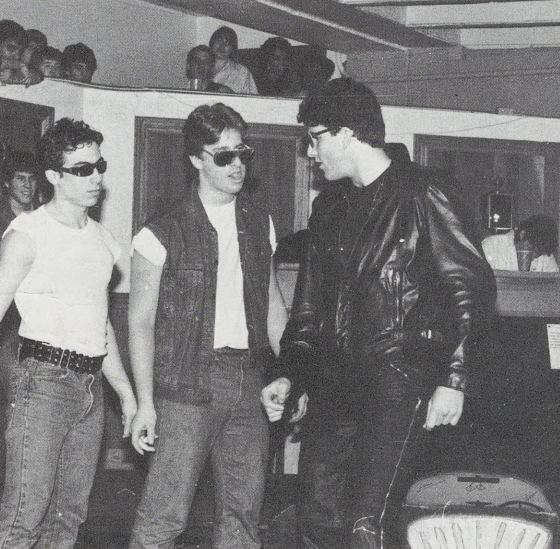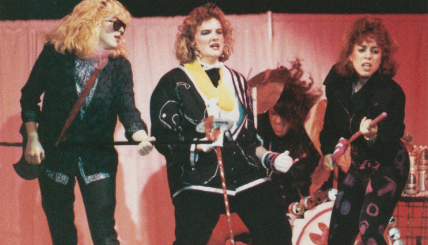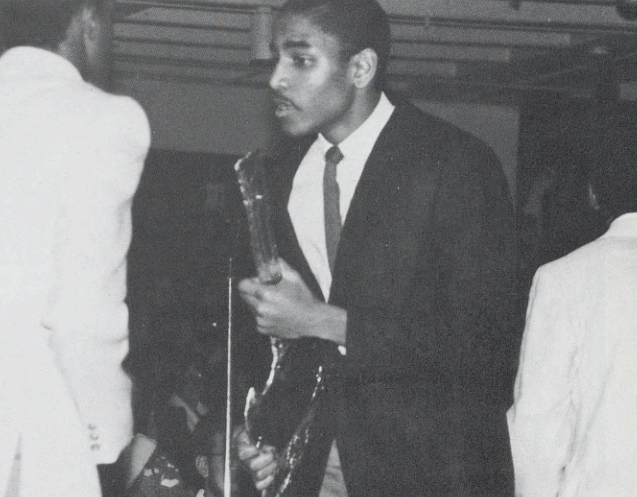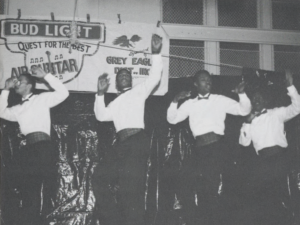By Matt Hampton | June 14, 2024
It may have been an off-the-wall concept, but from its debut in 1984, Airband became an instant hit and one of the most popular student events at Washington University in the 1980s and ’90s.
Each spring, groups from across campus cobbled together cardboard sets, donned extravagant costumes, and competed to lip-synch the hits for glory — and a cash prize.
Many of the groups that competed in Airband were fraternities and sororities, says Steve Toran, AB ’87, who performed a medley of songs from Grease with several other Alpha Epsilon Pi members in 1984 and ’85.
“We signed up for it kind of as a goof,” Toran recalls with amusement. “We prepared for a few weeks, and one of my fraternity brothers, Steve Zaslav [AB ’87], who played the male lead, had a little bit of theatrical experience in high school, so we set about choreographing it. Most of us had no rhythm and no talent musically, so to develop something that we could dance to and not look absurd was the real challenge.”

Another contestant in Airband’s first two years was a group calling itself Black Pearl, an ensemble of Black and African-American students, most of whom had some connection to the African and African American studies program in Arts & Sciences.
“Most of us had no rhythm and no talent musically, so to develop something that we could dance to and not look absurd was the real challenge.”
Steve Toran, AB ’87
One Black Pearl member, Aurelio Lee, AB ’85, recalls rehearsing Michael Jackson’s “Thriller” on the South 40 with a keg of beer and a VHS tape of the music video.
“This was before you had phones, so someone had to wait for it to come on MTV and capture it on a VCR,” he says.


Leading up to the event, word spread among students, and excitement mounted. When the big night arrived, spectators packed the Gargoyle to capacity. Among the ping pong tables in the gaming room, contestants got in costume and chatted, while the audience downed drinks, anticipating the spectacle about to unfold.
“People were interested to see what was going to come of it,” Toran says. “The enthusiasm was surprising for us. I think those of us who were performing didn’t want to get liquored up and fall off the stage or embarrass ourselves. Some of us were a little embarrassed to be participating to begin with, but it was all in good fun.”
“All I remember was it was so hot, so sweaty, so humid,” Lee says. “The floors were covered with liquid from people sweating and spilling beers. The stage was a bare-bones situation. The arts department put up a couple of Lekolites, so you had a bit of yellow and blue lighting and red and green lighting. The sound system was just the Gargoyle’s PA system.”
The night featured various bands’ performances, including “Calling Dr. Love” by KISS, “Y.M.C.A.” by The Village People, and AEPi’s Grease routine complete with ’50s leather jackets, shades, and white T-shirts. Finally, the show finished with Black Pearl.
“My brother loaned me his red Sasson jacket, so I looked very ‘Thriller’-esque,” Lee says. “One of the girls from the theater department put some makeup on us, and we got some old clothes and ripped them up a little bit. A couple of the guys were in the architecture school, so they built some fake coffins out of cardboard.”
With the lights low and mist drifting from a smoke machine, Black Pearl walked to the stage, some friends acting as “bodyguards” to part the crowd. The band went on to replicate the famous John Landis-directed music video, wowing the crowd and judges for a first-place prize.
“When we didn’t win our first year, it was deservedly so,” Toran says. “Their performance of ‘Thriller’ was unbelievable, I think both because they had a lot of talent and also because they were really into it.”
The enthusiasm remained the following year. According to the Student Life newspaper, attendees showed up almost four hours ahead of time, and the “line stretched from the Gargoyle all the way upstairs and out the door.” Those who did not find room in the Gargoyle watched on CCTV from the Umrathskeller nearby.

Black Pearl impersonated Morris Day and the Time, while AEPi reprised its Grease act with enhanced production value. Student Life reported that Black Pearl placed second and AEPi won third prize for their performance, which included a “guitar solo” on a tennis racket wrapped in Christmas lights.
“Our guitarist, Rodney Montag, [AB ’87], sported eyeglass frames with battery-powered penlights taped to the temples,” Toran says. “Set against the suddenly dark stage and a strobe light, it actually looked kind of cool.”
Toran says that performances became more theatrical over time as groups competed to outdo one another.
“Some of the performances were just straight musical imitations, guys pretending to be ACDC, things like that,” he says. “Some of them were elaborate, almost like music videos live on stage.”
Toran notes that this was in the days when MTV still played music videos and suggests that MTV inspired the popularity of Airband.
Soon, the event moved to the Athletics Complex to accommodate growing crowds, which reached as many as 5,000 by 1988.
In addition to providing entertainment, Airband also served as a mechanism for charitable giving, each year raising money for a charitable organization ranging from Youth Emergency Services to the Leukemia Society of America.
Eventually, Airband’s heyday faded, and in 1995, the event was cancelled due to low interest.
However, it will forever live on in the memories of alumni as an event that brought students together for a night of laughter and showmanship. It was a competition that allowed the most dedicated groups to show off their creativity and performative exuberance, and yet, was accessible enough that anyone with some old clothes and a few friends could put on a show.
“It’s music for somebody who doesn’t have to have any musical talent,” says Toran. “You’re playing an imaginary guitar, playing imaginary drums, lip-synching into a microphone that’s not turned on.”



